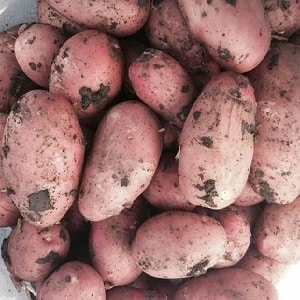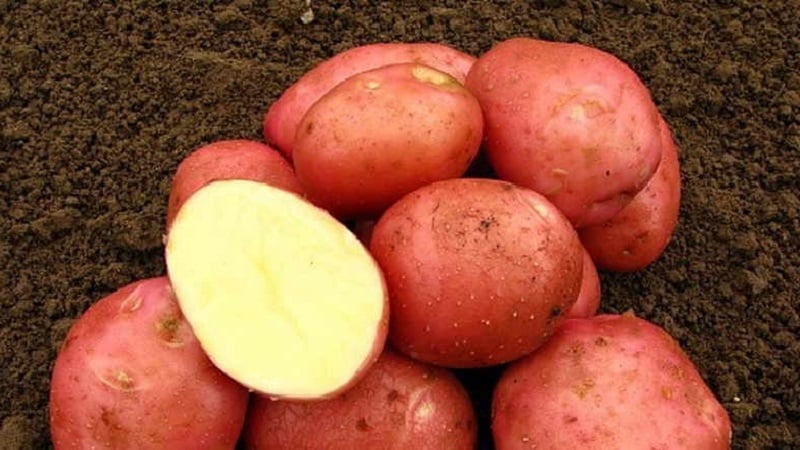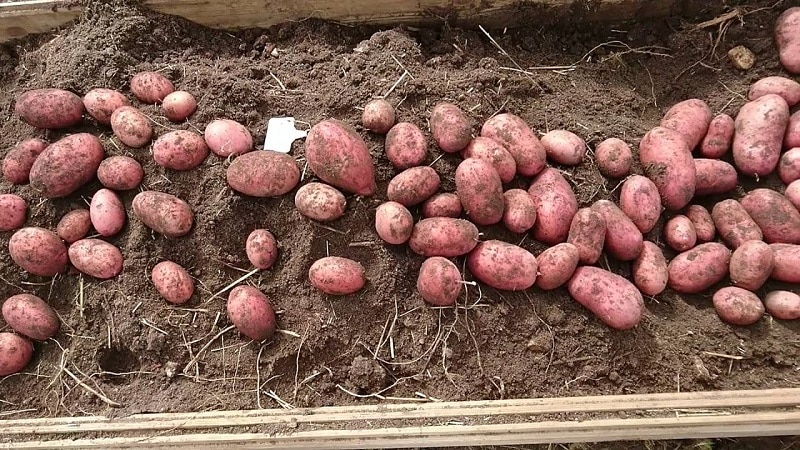Why gardeners love to grow Cherry potatoes: characteristics and description of the variety
Cherry potatoes are a variety grown by many gardeners. Its official name is Bellarosa, and the potato is called “cherry” because of the pink color of the tubers. The culture is early ripening, undemanding to care. Resistant to potato blight and golden nematode. Its attractive presentation and high yield make it possible to cultivate Cherry on an industrial scale.
What kind of potato is this?
This early variety has excellent tuber flavor. They grow it both for their own consumption and for sale.

Origin and development
Bellarosa was developed in Germany breeders from EUROPLANT Pflanzenzucht GmbH. Potatoes met all expectations and quickly became in demand among farmers. In 2006, the variety was included in the State Register of the Russian Federation.
Peculiarities
Cherry potatoes are easy to distinguish from other varieties. Its signs:
 The height of an upright bush is about 75 cm.
The height of an upright bush is about 75 cm.- The leaves are slightly wavy at the edges and large.
- During the flowering period, the corollas take on a red-violet hue.
- The tubers are round-oval with smooth or slightly rough red skin. Weight - 117–207 g.
- The pulp is dense with a yellow or cream tint. During cooking, the vegetables soften well and have a sweetish taste. The variety is early ripening, so the starch content in the tubers is low: 12.6–15.7%.
- The seedlings always grow evenly, without tilting.
The peculiarity of Bellarosa is the absence of flowering in some cases.. Many farmers who encountered this for the first time are worried that the plant is sick and will not produce a good harvest. However, Cherry is an early variety: the plant simply does not have time to bloom while the tubers are successfully forming. The absence of flowering has virtually no effect on crop yield.
Reference. Another characteristic of the Cherry is that it drops leaves and flowers. As a rule, potatoes grow at air temperatures no higher than +21°C. In case of warmer weather, the plant gets rid of the above-ground parts.
Description and characteristics
When standard agricultural practices are followed, the risk of crop loss is low. Tubers ripen 50–60 days after planting. There are 8–10 potatoes per bush.
Productivity of the variety is high: 169–326 c/ha. On the 45th day after emergence, 143–277 c/ha are harvested, on the 55th day – 170–385 c/ha. The maximum rate (385 c/ha) was recorded in the Tambov region.
How to grow
Bellarosa is unpretentious and does not require special attention.
Landing dates and rules
A few weeks before planting potatoes prepare the tubers. They are placed in boxes or scattered in a dry, bright room at a temperature not exceeding +15°C. Keep it until the vegetables sprout.
The site for planting is prepared in the fall: the soil is loosened and fertilized with humus or compost (per 1 m2 add 5 kg). In the spring, the soil is dug up again.
Important! Choose a ridge that is well lit and protected from strong winds.
During sowing take into account the size of the potatoes. The distance between the holes is 40 cm, between the rows - 90 cm. The depth of the holes is 10 cm. 1 tsp is placed in them. potassium-phosphorus fertilizer, plant potatoes and sprinkle with soil.
Planting dates depend on the climatic conditions of a particular region and weather.. The main thing is that the earth warms up to +10...+12°C, and the last spring frosts pass. For example, in the south of Russia the crop is planted at the end of March, in the Moscow region and mid-latitudes - in the last days of April, in the Urals and Siberia - in the first ten days of May.

Care
Cherry care is standard. First of all, they regularly loosen the rows, hill up the bushes and remove weeds.
Bellarosa will have enough rainwater, but thanks to additional and timely watering she will develop better. Therefore, during the growing season, plantings are irrigated 2-3 times.
Spray plants against pests only folk or biological substances. This variety rarely gets sick, so for prevention, two-time treatment with any folk remedy is enough.
Feed the culture 3 times:
- as soon as the first shoots appear, chicken manure is used;
- before flowering, add a mixture of urea and wood ash (100 g each) or potassium sulfate (10 g);
- when the cherry begins to bloom, add a mixture of 200 g of mullein and 40 g of superphosphate, diluted in 10 liters of water.
Fertilizers are used to stimulate the growth of tubers, apply them only after rain or watering.

Possible difficulties, diseases and pests
Basic nuances of growing cherries:
- plantings are kept clean, weeds are removed in a timely manner;
- after heavy rainfall and irrigation, the soil is loosened shallowly;
- bushes must be earthed 2 times per season, when the plants reach 15 cm in height and 2 weeks after, other procedures are carried out as necessary;
- To ensure that potatoes are healthy, environmentally friendly and of high quality, organic matter diluted in water is added to the soil;
- insufficient plant development indicates a lack of nutrients, so complex fertilizers are used.
Cherry is resistant to major diseases, but is affected by waterlogging late blight. During prolonged rains, the crop is treated with copper sulfate and Bordeaux mixture.
During the flowering period, the vegetable is susceptible to attacks by ground beetles and spotted potato beetles.. Other dangerous pests are wireworms and Colorado potato beetles. Insecticides are used against insects.

Collection, storage and use of crops
Collecting tubers 60 days after emergence.
Important! A sign of full ripening of potatoes is yellowing tops.
Before digging up the tubers, the tops are cut off up to a level of 15 cm above the ground. Thanks to this, the vegetables will ripen and the peel will become much rougher. This will increase the transportability of the crop.
The collected potatoes are dried for a week in the fresh air., select damaged and diseased tubers.
Store the harvest in the cellar or basement. With constant air circulation and a temperature of about +4°C, potatoes retain their presentation and taste for 7-8 months.
Cherry is a table variety, universal in cooking.. Tubers do not become overcooked during heat treatment and retain their taste.

Advantages and disadvantages of the variety
Basic virtues of Bellarosa:
- early ripening - the first harvest is dug out after 1.5 months;
- excellent presentation of tubers;
- stable harvest due to the variety’s resistance to climatic and weather conditions;
- stable immunity to major diseases;
- drought resistance: potatoes tolerate heat easily;
- long-term preservation of the crop;
- undemanding to soil composition, the only exception is heavy clay soils;
- sweetish taste of the pulp.
Flaws:
- tubers become smaller and develop poorly when there is insufficient lighting;
- At high humidity, potatoes are affected by late blight.
What regions is it suitable for?
Cherry zoned for Northwestern, Volga-Vyatka, Central Black Earth and Ural regions of the country, but it also grows well in other areas. In warmer climates, farmers harvest 2 crops per season.

Reviews
Most vegetable growers are satisfied with the variety, which is confirmed by positive reviews online.
Elena, Tambov: “I’ve been wanting to start growing Cherry for a long time and finally decided to do it. The harvest turned out to be high-quality and rich. There were no problems with diseases or pests. Potatoes were not affected by the drought. It lasts for a long time, and the taste is simply delicious!”
Gregory, Perm: “I decided to plant Bellarosa after I saw my neighbor’s harvest. It was the right decision. The tops are dense, the bushes are tall and strong. Even before active flowering began, I dug up young tubers. I liked their taste. During transportation, the presentation does not deteriorate at all.".
Olga, Nizhny Novgorod: “Once I noticed beautiful potatoes with pink skin at the market. I decided to try it. The whole family liked the taste, so I started looking for the name of the variety. It turned out to be Bellarosa (or Cherry). I planted it and was pleased with the results. The tubers look like in the photo, smooth and round. The taste was even better than purchased vegetables".
Conclusion
Cherry is a favorite potato variety among summer residents from different regions of Russia. The crop ripens quickly, is undemanding to care, resistant to many diseases, consistently produces a rich harvest, which is stored for a long time (keeping quality - 93%).The marketable appearance and sweetish taste of the tubers make them versatile in cooking and suitable for growing for sale.